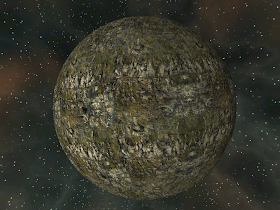 |
| Very first voxel planet (256^3 grid) |
Modelled as an earth side planet, the 256^3 data makes each voxel almost 50 Km on a side!
Now perfect spheres can only be so interesting, so adding some relief detail was my next job. Although completely arbitrary shapes are possible with voxels I wanted to get started with some fairly traditional planet forms so the initial focus was on producing something reasonably realistic. I've used a variety of fractal functions in the past to simulate terrain, ridged multi-fractals being a popular choice but such terrains tend to suffer from a large degree of homogeneity - they tend to have a large degree of self-similarity especially across large areas even when combining numerous frequencies.
In the spirit of trying new things, rather than tread that worn path again I wanted to try something different for Voxelus. Rather than generate heightfields from fractals, I wanted to see if I could generate something suitable using real-world Digital Elevation Model (DEM) data. A little searching turned up the Shuttle Radar Topography Mission (SRTM) data which is available in a variety of resolutions. Downloading this and writing a little command line tool to load and cut out interesting sections of it enabled me to produce a library of DEM tiles that I could use.
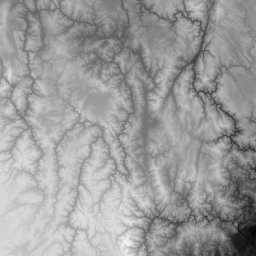 |
| Two examples of DEM patches my tool cut out of the massive SRTM 500m data set |
Armed with my library of DEM tiles I needed a way to map them onto my planet. Mapping 2D squares onto a sphere is however a classically impossible task (ask any cartographer) so rather than being able to make some perfect mapping I instead needed to quilt the surface with overlapping tiles, using as few as possible while ensuring that there were no gaps in between. I also wanted to be able to quilt at various resolutions so I could combine several "octaves" of DEM data in a traditional fractal-esque fashion.
To do this, I based my mapping on an Icosahedron, a regular polyhedron made up of 20 triangles.
| Icosahedron (image from Wikipedia) |
To map my DEM tiles onto the sphere I treat each triangle of the icosahedron as representing one tile. The centre of the tile lies on the centroid of the triangle and extends outwards to cover the triangle completely. Each tile also has a random rotation around the centroid so to ensure that there are no gaps between the tiles from adjacent faces, the tile has to be twice the radius of the triangles circumscribed circle in size. There will be considerable overlap around the edges between adjacent tiles but that's all the better to avoid seams.
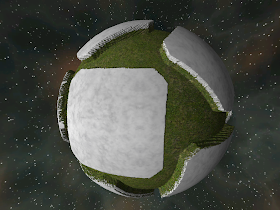 |
| First "octave" of DEm tiles at primary icosahedron vertices, there are 12 tiles here |
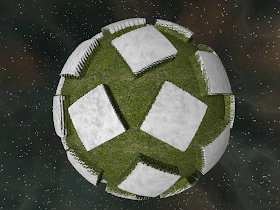 |
| One further level of subdivision produces 42 smaller tiles |
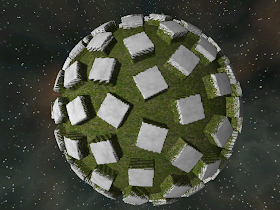 |
| Subdividing again produces 162 even smaller tiles |
Expanding the tiles to their correct sizes and repositioning them at the triangle centroids rather than the vertices produces a more accurate result:
Here the individual tiles have been tinted to aid identification and the edges shaded green based upon the weight of their influence at that point. As you can see the weight of each tile fades off towards it's edges to avoid hard seams and there is no space between them regardless of their orientation to ensure a complete mapping of the sphere. I've added a simple directional light so the relief from the DEM data can be seen.
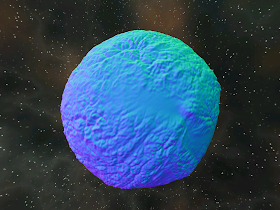 |
| Normals from just the basic level #0 data |
Finally here is the same level #0 data with some basic elevation/slope based texturing applied. Even with just one level of DEM data I am quite pleased with the appearance of the terrain, particularly with the variety of landscape forms in evidence which encourages me that this technique might just be viable.
The coarse 256^3 nature of the data can be quite clearly seen in this image even from this distance so I think starting work on the dynamic resolution subdivision system for closer views might be next on the list of things to tackle.





so it's possible to mix voxel an heightmaps and otain an acceptable result the uncertainty was refraining em from kaing the voxel jump as i though i would have to rewrite my whole heightmap generator.
ReplyDeleteAnyway impresive good job
Thanks David. You can certainly mix them, but the compromises inherent in voxels make them a generally worse option if you don't need their generality. Heightfield grids are ubiquitous because they are simple and efficient - largely due to their limitations.
ReplyDeleteI'm just going to saunter over and point out how much that last picture looks like Saturn's moon Iapetus: https://en.wikipedia.org/wiki/Iapetus_%28moon%29
ReplyDeleteFantastic work! Looking forward to more updates (and dare I say it, to fly around these worlds myself).
Looks pretty convincing :)
ReplyDelete